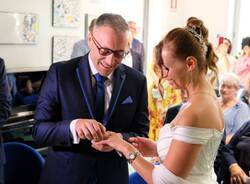Laveno and ceramics, a merger within two centuries
The failure of the ceramics company Richard Ginori, decided by the Court of Florence, cancelled a piece of history of the town. Here are the steps of its success and decline
 The failure of the ceramics company Richard Ginori, decided today, 7th January, by the Court of Florence, put an end to a fact that, for over a century, has also concerned Laveno Mombello, a town that is well-known for its production of precious ceramics. Let’s go again through some of the main steps that made a local production famous; that is now in the Museum of Ceramics in Cerro.
The failure of the ceramics company Richard Ginori, decided today, 7th January, by the Court of Florence, put an end to a fact that, for over a century, has also concerned Laveno Mombello, a town that is well-known for its production of precious ceramics. Let’s go again through some of the main steps that made a local production famous; that is now in the Museum of Ceramics in Cerro.
It was in 1856 the time in which Messers Caspani, Carnelli and Revelli, who came from the ceramics company Richard Ginori, in Milan S.Cristoforo, founded the ceramic company CCR in Laveno, in the warehouse of the former glassmaker Franzoni, based where the establishment “Lago” was created some time ago. However, the company would be transformed into S.C.I. S.p.a. (the Italian Society for Ceramics) in 1883.
In 1885, Revelli left S.C.I. and founded the Società Ceramica Revelli in Monbello and after ten years, Tommaso Bossi took the chairmanship of S.C.I. Also, electricity was introduced.
In 1923, the architect Guido Andloviz, who would be artistic director and designer for many years, joined the S.C.I..
Two years later began the period of maximum expansion of ceramics in Laveno because between 1925 and 1926 a big extension plan, that consisted in the building of general warehouse linked with the State Railways and of the Boesio Mills for the preparation of the refractory white paste, was accomplished.
The new departments were linked with the Lago factory thanks to an electric train. Furthermore, some houses for the white collar and blue collar workers were built. In the same period the Verbano factory for the production of ceramic isolators was built thanks to an agreement with Porzellanfabrik Rosenthal of Selb (Baviera); in 1931 the Verbano factory started the production of crockery ceramics. The war finished and in 1950, the Professional School for Ceramicists, led by the goldsmith Ambrogio Nicolini, was created: seven years later, it will be changed into the School for the Work Training of the Country and the building was given to the city of Laveno.
Another turning point was in 1965: S.C.I. was taken over by Richard Ginori.
The problems began with the increase of the labour costs and the foreign competitiveness in the eighties. At the beginning of the decade, after many changing in the property, the ceramic factories were in crisis. The Verbano factory was closed in 1982, from the 1st of March, the workers of the Lago factory were immediately made redundant: this is the final closure. Between 1990 and 1995: even the other factories closed quickly one after the other starting with the Verbano one and finishing with the factory of Laveno Ponte at the beginning of the new century.
La community di VareseNews
Loro ne fanno già parte
Ultimi commenti
Roberto Ganna su Elsa Fornero a Varese: “Abbiamo tolto futuro ai giovani. Ora dobbiamo restituirglielo”
Baffetta su Elsa Fornero a Varese: “Abbiamo tolto futuro ai giovani. Ora dobbiamo restituirglielo”
Fabrizio Tamborini su Elsa Fornero a Varese: “Abbiamo tolto futuro ai giovani. Ora dobbiamo restituirglielo”
Alessandro Zanzi su Elsa Fornero a Varese: “Abbiamo tolto futuro ai giovani. Ora dobbiamo restituirglielo”
Emanuele Zanetti su Motociclista di Ferno ucciso da un orso in Romania
GrandeFratello su Superate le 700 firme per la petizione sul recupero del Grand Hotel Campo dei Fiori di Varese
















Accedi o registrati per commentare questo articolo.
L'email è richiesta ma non verrà mostrata ai visitatori. Il contenuto di questo commento esprime il pensiero dell'autore e non rappresenta la linea editoriale di VareseNews.it, che rimane autonoma e indipendente. I messaggi inclusi nei commenti non sono testi giornalistici, ma post inviati dai singoli lettori che possono essere automaticamente pubblicati senza filtro preventivo. I commenti che includano uno o più link a siti esterni verranno rimossi in automatico dal sistema.